 |
| |
| |
COMIC PACKS
THE STORY OF THE ORIGINAL
COMIC BOOK IN A BAG
THE 1960s & 1970s
|
| |
|
| |
 |
| |
| 1962 - A DOUBLE-EDGED YEAR
FOR THE COMIC BOOK INDUSTRY |
| |
| As the year
1962 rolled around, the US comic book industry found
itself confronted with a true dilemma. On the one hand,
it had done nothing less than re-invent itself as the
superhero genre - clinically dead for most of the 1950s -
had made a staggering comeback with the introduction of
new and instantly successful team titles (spearheaded by
DC's Justice League of America in 1960 and
Marvel's Fantastic Four in 1961), modernized
relaunches of Golden Age heroes (such as DC's Green
Lantern, Flash and Hawkman) and
new superhero characters (such as Archie's Fly
or Charlton's Captain Atom). There was a streak
of new creativity and enthusiasm throughout the whole
industry as it was poised to launch even more characters
which would enter and change comic book history. On the other hand,
the entire industry was looking to 1962 with apprehension
- for the simple and yet highly complex reason that for
the first time in the perceived history of comic books
the publishers were forced to raise their prices. Ever
since the 1930s, comic books had cost 10¢. In order to
hold that price, publishers had significantly lowered the
page count of their titles over the years to finally
arrive at only half of the original 64 pages comic books
had in the 1930s. This time, however, there was no way
around it, as rising production costs and inflation cut
too deeply into profit margins. But raising that cover
price was a psychologically difficult task to perform -
if too many readers would end up buying fewer comics then
the industry would ultimately lose more than it stood to
gain from the price increase.
Market
leader Dell jumped in first and headlong with a
staggering 50% increase from 10¢ to 15¢ in 1961 - only
to face desastrous results. The competitors held out for
a brief while, even capitalizing on the move by running
"still only 10¢" blurbs on their covers, but
eventually they all had to follow suit by early 1962 -
even though they only went up to 12¢. But this was still
a 20% price increase, and the drop in sales was brutal
across the board - DC Comics alone being rumoured to have
lost more than $600,000 in comparison to the previous
year (Wells, 2012); the statements of ownership required
by the US postal services show that the sales figures for
DC flagship titles such as Superman, Action
Comics and World's Finest dropped by around
25% in 1962 as compared to 1961.
At least the
industry had seen it coming, and some had planned on
several countermeasures. Some didn't work at all (such as
a loyalty scheme introduced by Dell), but DC Comics had
an idea which would prove to work out rather well: the COMICPAC.
|
| |
| INTRODUCING THE
"COMICPAC" |
| |
| The
intention was straightforward and made good business
sense - open up new sales opportunities and markets and
thus tap into a new customer base - and the concept which
followed from this was a fairly simple one: sell comic
books in packaged bundles as opposed to the classic
newsstand individual copy. The original idea was to combine four
different individual comic books using a sealed plastic
bag carrying a folded cardboard top as container, and on
November 30th 1961 National Periodical (i.e.
National Comics, i.e. DC Comics) submitted the name COMICPAC for trademarking.
|
| |
| The trademark was duly registered as
such by the US Patent Office on August 14th 1962 for the
purpose of producing, marketing and selling
"packaged comic books". Included in the
trademark was a graphic branding sign reading COMICPAC in shadowed
lettering which featured as the initial label and
visual tag both on the plastic bags themselves as
well as in in-house advertisements in DC's own
line of comic books. |
|
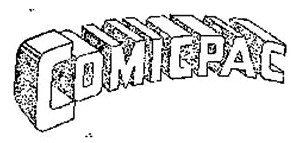
|
| |
|
|
|
| Intially
the readers' attention was drawn to the
new concept with a 1/3 page full-colour
ad ("HAVE YOU SEEN THE
NEW COMICPAC")
which appeared, amongst other titles, in Blackhawk
#175 and Strange Adventures
#143, for the August 1962 cover date
production run. The ad is interesting
because it doesn't even clearly state
what a Comicpac is - this had to be
deduced by the reader from the
illustration of one, showing the cover of
the at the time current issue of Action
Comics.
Instead of
actually explaining the product, DC
emphasized where it could be purchased:
at supermarkets.
|
|
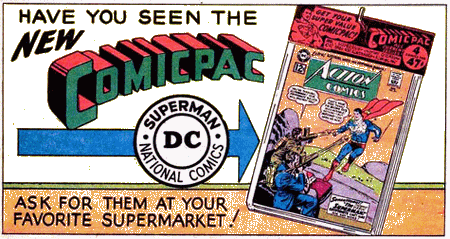
In-house
ad from Blackhawk #175 (August 1962) for
DC's "new" COMICPAC,
featuring a bag containing Action Comics
#291 (August 1962)
|
|
|
| |
| A second in-house ad, which
ran in a number of DC titles of the January and February
1963 cover month production (and which thus was just in
time for Christmas as the cover month was usually about 3
months ahead of the actual publication date) took up a
full page, was placed on the inside cover, and explained
in much more detail what the Comicpac was all about. |
| |
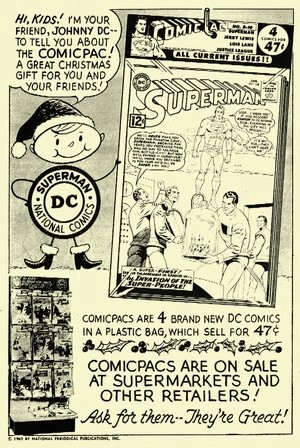
In-house
ad from the inside cover of Detective
Comics #311 (Januuary 1963) for DC's
"new" COMICPAC,
featuring a bag with Superman #158
(January 1963)
|
|
The ad featured newly
introduced mascot "Johnny DC"
who pointed out the Comicpac as a great
Christmas gift to readers of e.g. Detective
Comics #311
(January 1963), Strange
Adventures #148 (January 1963), Rip
Hunter - Time Master #12
(January-February 1963) Action Comics
#297 (February 1963), Superman's Girl
Friend, Lois Lane #39 (February
1963), and Tales of the Unexpected
#75 (February-March 1963). This time it was
explained that a Comicpac was a plastic
bag holding four brand new DC comics and
that they sold for 47¢
(which the regular comic book reader knew
was one cent less than what you'd pay for
four individual issues), but the emphasis
once again was on their point of sale:
supermarkets (and other retailers).
Today, the attention
of many comic book fans seems to be drawn
to the price (on those rare occasions
when comic packs are discussed in online
fora), and many seem to mistakingly think
that what was essentially simply a price
tag was a discount advertising and even
the driving idea behind the Comicpac
concept.
In reality, the one
cent discount would obviously have been a
very weak selling point. Accordingly, DC
never even pointed that out (the
prominent blurb on the bag simply stated
the price of the Comicpac and the number
of comics you got), not the least because
that minimal saving would often be erased
anyway by the fact that comicpacks could
be subject to sales tax at the
supermarket check-out (Evanier, 2007a).
|
|
|
| |
| Besides - offsetting the
losses in sales caused by the 1962 price increase by
trying to sell 4 comics for a discount of one cent would
have been a hopeless idea. But compensating the downturn
in the established customer base by tapping into a new
one was most definitely something which could work and
help alleviate - or even turn around - the situation. The primary idea DC
was thus pursuing with its Comicpac was to break into new
sales opportunties and reach a customer base which, for
one reason or another, simply didn't buy comics off the
newsstand or spinner racks. And one place these
individuals could be found were the growing number of
supermarkets and chain stores.
|
| |
| THE MAGIC WORD: PACKAGING |
| |
The comic book industry was
faced with a growing problem: they were offering a
commodity which proved increasingly cumbersome to receive
and handle - and which yielded only marginal profits with
sales at a price of 12¢ per item. Furthermore, the comic book's traditional retail
outlets - small community stores and newsagents - were
increasingly giving way to larger stores which were not
interested in selling comics. The number of distribution
outlets was shrinking, and the distribution system per se
did nothing at all to counteract this development - on
the contrary.
"A few
retailers actually liked carrying comics, but most
were indifferent. Comics weren’t after all, an
absolute necessity to most retailers who sold
periodicals, in the way that Cosmopolitan, Playboy,
Time and Sports Illustrated were. So, let’s say
[the local distribuor] actually delivered 5,000
copies [of 10,000 received at the warehouse] to the
retailers. If they bothered to deal with
unwrapping and sorting, if they had room on the
trucks… Most likely, they’d only
actually deliver comics to retailers who would
complain if they didn’t get comics and places
that sold enough comics to make the driver’s
effort worthwhile." (Shooter, 2011)
|
| |
| In stark
contrast to the comic book's
historical sales venues,
supermarkets were booming. They
were popular because they sold
many different things under one
roof - and evidently, comics were
not amongst the merchandise they
carried. In order to
change this, the whole concept of
selling comic books had to be
revised. Handling individual
issues clearly was no option for
these outlets, but by looking at
their logistics and display
characteristics DC found that the
answer to breaking into this
promising new market could be - a
simple plastic bag.
Packaging
defined the Comicpac in the first
place, but it was also its magic
word which opened the doors of
the supermarkets to DC's comic
books.
Putting
four comic books into one
container resulted in a higher
price per unit on sale (47¢ rather
than just 12¢), which made
the whole business of stocking
them much more worthwhile for the
seller. The simple packaging was
also rather nifty because it
clearly showed the items were new
and untouched, which in turn did
away with individual comic books
starting to look tatty after a
dozen individuals had taken them
off the rack, thumbed through
them, and placed them back again,
often with little to no care.
Packaged
in plastic bags, DC's comic books
literally blended in with a large
proportion of other goods sold at
supermarkets - also conveniently
packaged.
|
|
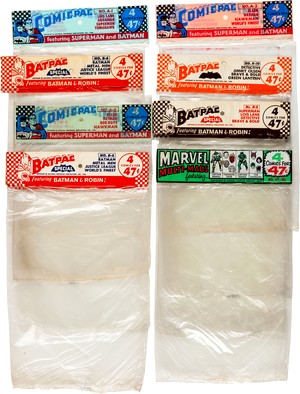
Various unused plastic bag
packaging for DC and Marvel
comicpacks from the 1960s
|
|
|
|
| |
| Presented this way, comic
books became sellable to supermarket shoppers - giving DC
access not only to new market opportunities, but to a
whole new customer base. |
| |
| HEY (GRAND)PARENTS - COMICS ! |
| |
The
intention of tapping into the growing number of
supermarkets and chain stores as a potential sales ground
was tied to a very specific type of target customer:
"DC's
focus [for the Comicpac] was on both the casual
reader and the parents and grandparents who were
looking for gifts." (Wells, 2012)
This becomes
even clearer if you take a closer look at DC's packaging
concept for the Comicpac. By putting four comics into one bag,
only two covers were visible. Initially, the bags would
identify which titles were enclosed (though not the issue
numbers) so that buyers knew more or less what they were
getting, but when the number of comic books contained in
a comic pack was reduced to three at the beginning of the
1970s, this information was dropped.
|
| |
This
effectively turned the comic book in the middle
into a "mystery" surprise issue - and
as surprises go, they can be good or bad, and it
is precisley this element which made regular
comic book readers shy away from that comic book
bundle in a plastic bag.
"[They]
passed on the bagged comics since there was
usually at least one issue that they didn't
want or need." (Wells,
2012)
"I had
so many comics, the odds were I'd wind up
with dupes (...) that was why Comicpacs did
not work for me. Insofar as I could tell,
they didn't work for anyone."
(Evanier, 2007a)
Evanier's concluding
assumption is - as he himself was quick to point
out (Evanier, 2007b) - wrong. The Comicpac
actually worked just fine - for casual readers or
people not buying comics for themselves (such as
parents, grandparents, uncles and aunts).

The display sign
mounted above the Comicpac display rack read
"kids" - but really meant their parents
The fact that it
didn't work that well for avid readers lies with
the very principle of the Comicpac: packaging.
For obvious reasons the regulars didn't want
their comic books in a bag where they couldn't be
100% sure what they were buying. But the idea of
the Comicpac wasn't to annoy that customer base,
but rather to tap into a new one.
|
|
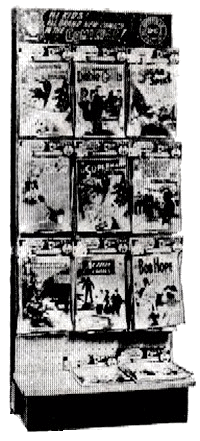
A dedicated
display rack for DC Comicpacs
|
|
| |
| And to those individuals,
the packaging actually held the added appeal of being
rather neat, doing away with having to deal with a bundle
of loose comics, and the sealed plastic bag made it look
much more sophisticated as a gift. Specific content was
of no real concern to the casual buyer as long as you had
a general idea of what you were getting, and DC even
provided stores with a dedicated display rack system. In
addition, the Comicpacs made sure that the selection
covered a wide range of genres - superheroes, funnies,
romance, western. And
finally there were those comic book readers who simply
did not have access to outlets who sold comics and
regularly restocked. To them, the Comicpac could more or
less be the only way of getting hold of comics at all.
|
| |
|
| |
Strategically placed close
to checkouts and cash points, DC's comic packs were a
success.
"The DC [comic
packs] program lasted well over a decade, with pretty
high distribution numbers. The Western program was
enormous - even well into the '70s they were taking
very large numbers of DC titles for distribution (I
recall 50,000+ copies offhand). The unknowable factor
on the DC program was that a certain number of
distributors and retailers simply split the packs
open and returned the loose comics, making an
arbitrage profit, and distorting the flow of actual
sales data so it looked like the packs sold near
100%. There was no clear pattern of these
"arbitraged" copies depressing the sell
throughs of the regular releases for most of those
years, though, until towards the end of the
program." (Paul Levitz, in Evanier (2007b))
Levitz is refering to the
fact that comic packs, unlike comic books distributed to
newsstands and other traditional outlets, were
non-returnable. Bags which didn't sell were thus the
seller's problem, not the publisher's.
|
| |
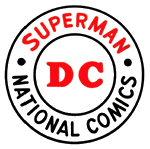
|
|
As such the
Comicpac was one of the first
attempts by DC to work their way
out of the traditional but
increasingly unprofitable setup
of reimbursing resellers for
unsold items - a business
model which of course did nothing
whatsoever to encourage actual
sales.
As an
example, Detective
Comics #433 (March 1973,
included in DC's 1973 D-3
Super Pac) carries the
required annual statement of
ownership and circulation, which
shows that whilst DC printed an
average of 332,000
copies per issue of Detective
Comics per month in
1972, only 158,638 of these (i.e.
less than 50%) were, on average,
actually sold.
|
|
|
|
| |
| And it wasn't just DC:
Marvel saw 65% of all copies distributed
throughout the 1970s being returned - and sometimes even
reimbursed without any physical proof (Groth, 2006). But
even if the traditional upper half of the cover was
returned it didn't stop some resellers from making an
extra profit by selling coverless comics. Just as the
comic packs didn't stop
anyone from ripping open the bags and returning the
individual comic books which hadn't sold as Comicpacs -
ultimately leading to specially marked covers as of the
late 1970s to counteract this fraudulent practice. The
comicpacks were thus also a first example of trying to
create something akin to what would eventually become the
direct market, where specialized comic book resellers
would get better deals but on a base of
non-returnability. |
| |
| Regardless of
these problems, Comicpacs sold
well. And when ABC launched its
Batman TV series in January 1966
and the show became an overnight
surprise sensation - "completely
burying the competition"
(Gerani & Schulman, 1977) - the comic
books in DC's plastic bags became
even more mainstream and sellable
- so much so that for a short
time DC even rebranded some of
its Comicpacs as BATPACs in an
attempt to hook onto the 1966/67
Batmania and all of its
merchandising craze. It really
was the show that turned Batman
into the popular culture icon he
still is today, and into a mighty
point-of-sale for DC at the time:
the "exposure the show
brought to the comics was
enormous" (Dixon,
2010), and sales of Batman
soared to 900,000 monthly copies
in 1966. By that time,
the Comicpac had already
successfully achieved what DC had
set out to do - to get comic
books sold in supermarkets. But
other than that - how successful
were these plastic bags overall? There are two
highly reliable indicators for
judging whether or not a business
or product idea is a success or
not: if it can generate and boost
demand, and if it leads to others
wanting to do the same thing.
The Comicpac
had successfully opened the doors
to supermarkets and chainstores
for DC comics, and in doing so
brought National Periodical into
direct contact with a company
which had accomplished a similiar
market entry 50 years earlier: in
1918, Western Publishing persuaded the
Woolworth Company to place
children's books on display in
its retail stores all year round,
something which previously had
only been done during the
Christmas season (biglittlebooks.com).
|
|
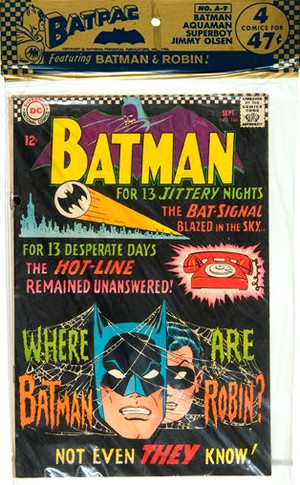
Batpac
A9 with Batman #184 (September
1966)
|
|
|
|
| |
| The public’s response
was so enthusiastic that Western developed a line
designed for a year-round market, and its success lead
Western to establish a separate book division for this
market: Whitman Publishing. |
| |
| 1967 - ENTER WHITMAN |
| |
| With established
connections to chain stores, Whitman gained a strong
presence in the form of large shelved display spaces. The
range began to extend beyond books to boxed games and
jigsaw puzzles, but the real ace product was the Big
Little Book® introduced in 1932. |
| |
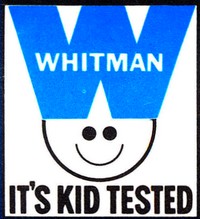
|
|
Whitman also
pioneered the licensing of comic
characters for various
publications (including the Big
Little Books) and entered into a
successful and ultimately
long-standing relationship with
Walt Disney Productions. In 1933
Western/Whitman secured exclusive
book rights to all the Walt
Disney licensed characters, and
in 1937 took over production and
publication of the popular Mickey
Mouse Magazine. Opening
offices in Poughkeepsie NY in
1935 entailed a close association
between Western and Simon &
Schuster as well as the Dell
Publishing Company, the latter
introducing Whitman ("kid
tested") to the comic market
proper (biglittlebooks.com), and it was
this backing through the finely
tuned distribution and display
presence of Whitman which made
Dell the number one comic
publisher - until the 1961 cover
price rise.
|
|
|
|
| |
| It was
therefore only a question of time that National
Periodical's successful strategy of introducing and
selling packaged DC comic books to supermarkets would
bring them into contact with Whitman - just as it was
only a matter of time before other publishers would start
to copy DC. It is evident that both companies could
easily profit from each other, and if National Periodical
could profit from Whitman's distribution and sales
network then that would more than make up for the
impending loss of the monopoly of the Comicpac. So in
1967 Whitman took over the distribution not only of DC's
comics, but of those of a quickly growing number of
additional publishers (McClure, 2010) - who wanted to
have a share in DC's successful Comicpac business scheme.
|
| |
|
| |
| Both
products could be displayed in absolutely the same way as
DC's Comicpac - not so the very austere three-pack from
King, which had no product name and just carried a
sticker on what was almost a shrink wrap which lacked the
hanger for a rack display. But unlike the competition,
King indicated the comparable value of the three
individual comics (36¢) and offered a far
"bigger" discount in comparison: 7¢ as opposed
to the one cent of the various other publishers (although
DC even put out a few comic packs in the late 1970s
without any saving at all). This points to the fact that
DC's Comicpac had paved the way for bagged comic books
into supermarkets and chain stores, so a new publisher
such as King (established in 1966) could at least try to
gain a slightly bigger piece of the cake (i.e. the
established new market) through pricing. It didn't work
for King, the very short-lived comic book imprint of King Features Syndicate,
which was set up to publish their syndicated characters
in their own range of comics (rather than as licensed
properties) - King Comics was shut down again by the end
of 1967. |
| |
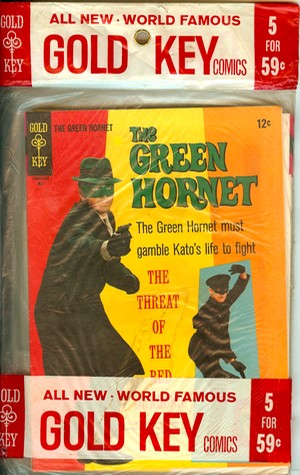 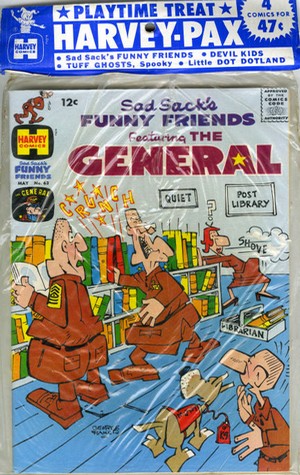 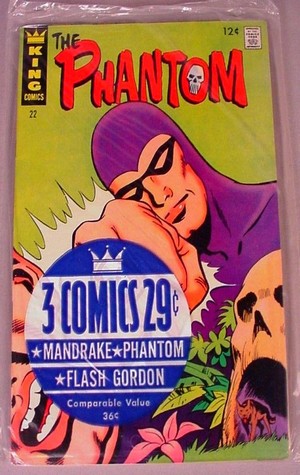
Packaged
comics from Gold Key, Harvey, and King - all 1967
|
| |
| At around the same
time in 1967, DC's Comicpac cardboard header
(which, as unopened bags from that era show,
could become quite tatty) was replaced by
printing directly onto the bag, soon to become a
general feature of all comic packs. Successful
and innovative Marvel Comics had just grabbed the
market leader position from DC in early 1967, and
the House of Ideas tuned in on the Whitman
distribution deal to supermarkets and chain
stores too, labelling its four-packs MULTI-MAGS and using
the character vignette in a box (Steve Ditko's
brainchild) to help buyers who were in the know
identify quickly which titles they were getting.
|
|
| |
 |
| |
| To all other
buyers - the aformentioned
parents, grandparents, uncles and
aunts - it probably didn't matter
anyway as long as they could see
and understand that they were
getting some Spider-Man. Whilst
basically picking up a business
idea from the "distinguished
competition" - as Stan Lee
would call DC after Marvel
overtook them in monthly sales
(prior to that DC had been
"Brand Ecch", i.e.
Brand X) - Marvel was at the same
time looking into other ways of
fighting the losses incurred by
the already mentioned system of
returnability.
Interestingly
enough, one such attempt has been
preserved in the time capsule of
a Multi-Mag, namely 68-A10, where
the cover of Amazing
Spider-Man #66 (November
1968) carries a blurb at
the bottom reading
"RETAILERS: See page 32 for
special display allowance
plan". Turning to page 32
revealed that retailers would
receive a 10% payment for all
Marvel comics sold (which would
have been 1,2 cents per regular
comic).
The
scheme does not appear to have
been a huge success, but it
graphically illustrates how
crooked and therefore both
unpredictable and unprofitable
the system of returnability had
become for comic book publishers,
who were increasingly looking for
alternatives as a way out.
Unlike
what many comic book fans
possibly thought at the time (and
even today), the comic packs were
a lone success story on that
playing field.
|
|
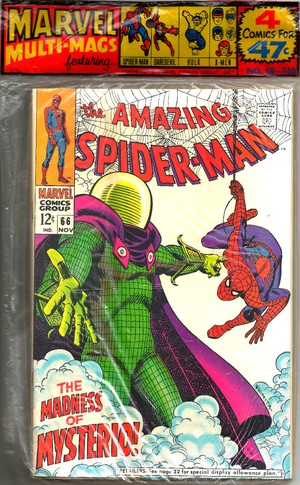
Marvel
Multi-Mags A10 with Amazing
Spider-Man #66 (November 1968)
|
|
|
|
| |
| Marvel, rather
surprisingly, dropped out of the comicpack market
in mid-1969 when the sale of the company to
Perfect Film resulted in a switch of both
printers and distributor, the latter being Curtis
Distribution (also owned by Perfect Film and
hence in-house) who replaced Independent - and
the Whitman distribution deal simply expired
alongside (cf. THOUGHT
BALLON #43). |
| |
| THE 1970s - THE
SUCCESS STORY CONTINUES |
|
| |
| With the benefit of
hindsight it is not difficult to see how DC's Comicpac
and its close cousins were a first step in going to where
the comic book industry would eventually find it's
survival lifeline: the direct market. |
| |
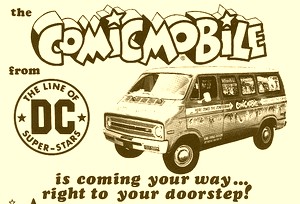
|
|
DC had other
"direct market ideas"
too, but most remained embryonic
and didn't really work out, just
like Marvel^s retailer allowance
plan. One of the most amazingly
fantastic attempts at tapping
into the market by selling comics
outside the newsstand
distribution system must have
been the Comicmobile. The
brainchild of DC's vice president
and production manager Sol
Harrison, it briefly toured the
NYC suburbs during the 1973
summer school break, sporting the
slogan "HERE
COMES THE COMICSMAN", and
stocked with surplus comic books
from the DC library.
The
end, however, came quickly.
|
|
|
|
| |
"When school
started, the Comicmobile’s hours of operation
were severely reduced (...) I’m sure part of it
also had to do with the fact that we were barely
making enough to cover the cost of gasoline the van
was guzzling… and gas was only 20c a gallon at
the time! The Comicmobile was shipped off to comics
dealer Bruce Hamilton out in the southwestern U.S.
for continued "testing." The entire
project, however, met an untimely end when the
Comicmobile came out on the losing end of a collision
with a semi." (Rozakis, 2010)
|
| |
| Again, this
only goes to show just how
successful the comic packs were
in comparison, and as the decade
which had seen the creation of
the Comicpac gradually came to an
end, more and more comic books
found their way into plastic bags
and then on to some supermarket
or chain store. As the 1970s
rolled around, an important
change took place - Whitman not
only took care of the
distribution and sales end of
things, but also started to get
involved in the packaging and
publication process itself. By
1972 Whitman was selling comic
book packs containing Gold Key
titles which had their logo
replaced by the familiar Whitman
face logo.
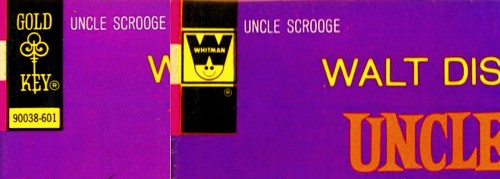
Initially
comprising of cartoon characters,
the Whitman comic packs were
branded as WHITMAN
FUN-PAC COMICS as of 1973.
Soon however the bags would also
hold other Gold Key licensed
property comics with a Whitman
logo, although these bags would
not carry a specific Whitman
marking (as seen with a three
pack featuring Boris Karloff
Tales of Mystery #70,
published in September 1976).
Sometimes these same bags would
also be used to hold Marvel comic
books - the example here comes
from 1977 - even though Marvel
still had its own Multi-Mags
programme at the time.
|
|
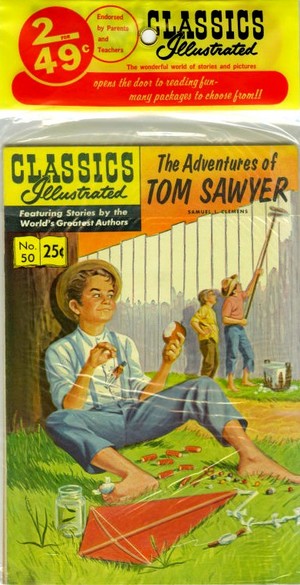
Classics
Illustrated two-pack from 1969
|
|
|
|
| |
| By 1975 Marvel was back in
the comicpack business, both with their own MARVEL MULTI-MAGS as well as bag packaged and
distributed especially through the Whitman network - and
these were actually the very first direct market editions
(bought by Whitman at a more favourable price than
newsagents could, but without the right to return unsold
copies). They were absolutely identical to their
newsstand edition cousins save for the white diamond in
black box containing the issue number and price (McClure,
2010). |
| |
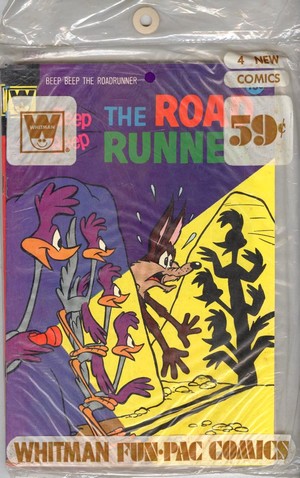 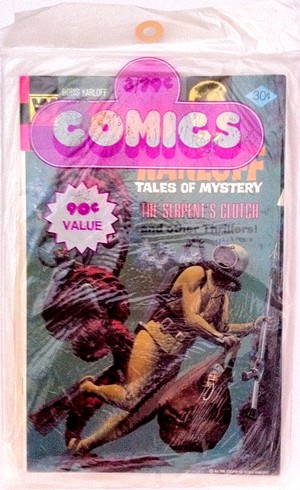 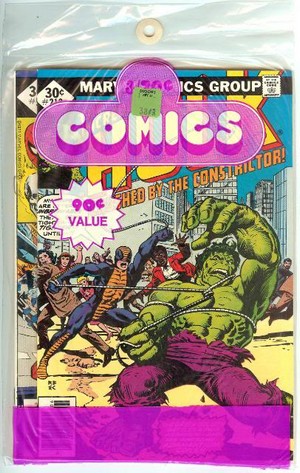 |
| |
| Then, as of 1977, Whitman
would also start to sell specific comic book titles from
Marvel in bags clearly marked "Whitman" after
Marvel took to licensed adaptations of science fiction
movies as of 1977. |
| |
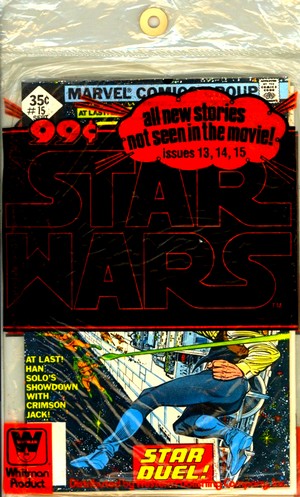
|
|
Spearhead
by the phenomenally
successful Star Wars
- which Whitman sold
packaged bundles of three
issues with continuous
numbering - these comic
packs also featured Battleship
Galactica or the Micronauts
- and as such never
contained mixed titles. Whilst
these comic packs carried
the Whitman Logo and a
branding
"Distributed by
Western Publishing
Company Inc.", the
inventor of the Comicpac
- DC Comics - still
offered its own comics in
packaging clearly marked
DC (alongside
"themed"
Whitman DC bags, e.g. 3
Superman comics in one
bag, with the DC bullet
logo replaced by the
Whitman roundel). The
name had changed from COMICPAC to SUPER PAC in
1970/71, but it was still
done to the same success
formula. By 1972 a DC
comic pack would as a
general rule (there were
exceptions) contain three
comic books, two of which
were visible on either
side of the plastic bag,
and one stuck in the
middle which sometimes
could be glanced, and
sometimes not.

|
|
|
|
|
| |
| Marvel was using different
distribution channels as well - sticking to their MULTI MAGS they also saw all the major
characters from the Marvel Universe sold in Whitman bags
(bearing the already mention white diamond in black
square). |
| |
| Probably
based on the success of the dedicated Star
Wars comic packs, Whitman started to
offer character themed bags which
typically featured three consecutives
issues of one title. These were clearly
marked, as can be seen from the Thor
(1978) and Conan (1979) examples below. 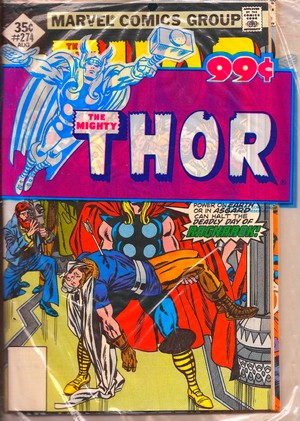 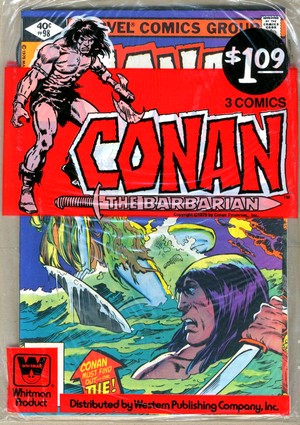
|
|
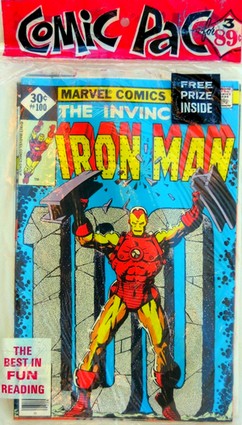
1977 "Comic Pac" with Marvels
Far left: Thor Pack from 1978
Left: Conan Pack from 1979
|
|
|
| |
| THE
SYSTEMATICS OF DC's COMIC PACKS |
| |
| When DC Comics
launched the Comicpac in 1961/62 they
went about setting up their new packaging
and sales concept in a very methodic way
- one aspect of which was that all of
DC's multi-comic packs were reference
numbered right from the start. |
| |
|
|
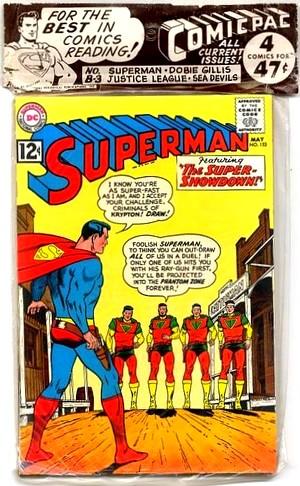
Comicpac
B3 from 1962, with Superman #153
(May 1962) as its showcased title
|
|
This
translated into a code using a
letter plus digit - for example,
the Comicpac pictured here is the
"B-3" pack from 1962.
Rather than just filling the
plastic bags at random with any
four comic books (initially all
placed with their cover facing
the same way, so that one side of
the plastic bag would only show
the ad on the outside back
cover), the Comicpac was thus a
clearly defined commodity, and
the 1962 B-3 pack would thus
carry the same four issues no
matter where or when it was sold.
Interestingly
enough this also means that
someone somewhere had to make the
decision which comics went into
which Comicpac. Little to no
information on this seems to be
publicly available, leaving open
to speculation the question
whether the selection was driven
by surplus stock or conscious
title selection. Whilst probably
a mix of both, there does seem to
have been a tendency to include
certain popular or iconic
characters and their books.
Throughout
the 1960s there were a total of
24 sets of Comicpacs per year,
coded A and B respectively and
numbered 1 to 12. By 1964 the
digit would refer to the month,
i.e. A-1 and B-1 would both
feature comic books with a
January cover date (or
January/February in the case of
bi-monthly titles) - a code
system which Marvel initially
also adapted for its Multi-Mags,
whilst other publishers would use
it in a fairly on/off way for
their comic packs.
It is hard to
tell if the casual buyers even
paid any attention to DC's neat
code system, but it is an
indication of how organized and
structured the comic packs
business at DC was. Marvel, on
the other hand, dropped codes all
together in the early 1970s, and
as a result there is no
systematic indication of how many
different Multi-Mags the House of
Ideas was releasing during the
1970s.
|
|
|
|
| |
| Just how
successful the Comicpac concept really was and how well
it worked for National Periodical is reflected in the
fact that after around 10 years of market presence, DC
doubled the number of comic packs packaged per year. By
1972, four packs were distributed each month, resulting
in a total of 48 sets per year, coded A to D and 1 to 12.
There even were extra runs at times, given the code EE. |
| |
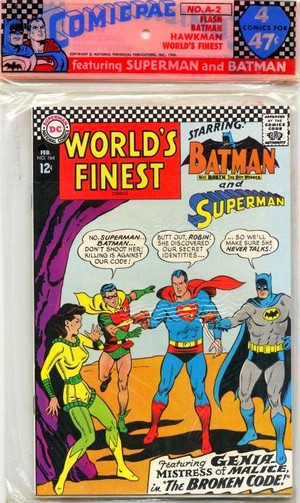 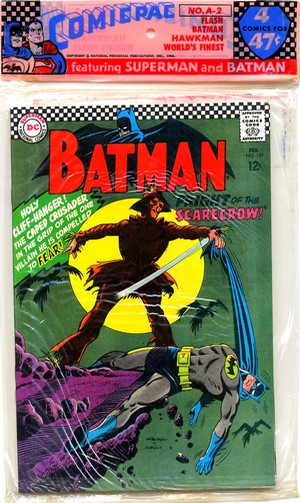 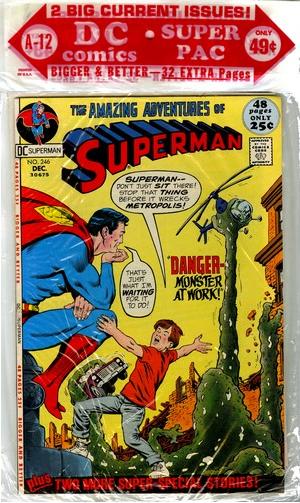
Two sides to a Comicpac (left and center): back and front
(you get to chose which is which) showcase covers of
Comicpac A2 from 1967,
with Batman #189 (February 1967) and World's Finest #164
(February 1967).
And then the Comicpac became the Super Pac in 1970/71
(right), A-12 showcased Superman #246 (December 1971)
|
| |
| By 1977, the DC Super
Pac briefly became DC Dynamite Comics and
then DC Dynamic Comics as of 1978. The high time
of the comic pack was over by the end of the decade for
all publishers, but various incarnations would be seen
throughout the following decade as the original comic
book in a plastic bag began to trickle out. Whitman
stopped distributing and selling comic packs with Marvel
and DC comics in April 1980. |
| |
| |
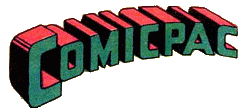
|
| |
| |
| BIBLIOGRAPHY DIXON Chuck (2010) "Known
Super-Criminals still at Large: Villainy in Batman",
in Gotham City 14 Miles: 14 Essays on Why the 1960s
Batman TV Series Matters (Jim Beard ed.), Sequart
Research & Literacy Organization
EVANIER Mark (2007a) "It's in the Bag!", published online in News
From Me
EVANIER Mark (2007b) "More on Comicpacs", published online in News
From Me
GERANI Gary & Paul H.
Schulman (1977) Fantastic Television, Harmony
Books
GROTH
Gary (ed.) (2006) The Comics Journal #277 (July
2006), Fantagraphics
McCLURE
Jon Martin (2010) "A History of Publisher
Experimentation and Variant Comic Books", in Overstreet
Comic Book Price Guide, 40th Edition, Gemstone
Publishing
ROZAKIS
Bob (2010) "The
Comicmobile", published online at Anything
Goes (Bob Rozakis Blog)
SHOOTER
Jim (2011) "Comic Book
Distribution", published online at jimshooter.com
WELLS John (2012) American
Comic Book Chronicles: The 1960s (1960-1964),
TwoMorrows Publishing
|
| |

|
| |
First
posted to the web 19 December 2013
Revised, updated and reposted 14 April 2014
Last updated 1 June 2016

Text
is (c) 2013-2016 A.T. Wymann
The illustrations presented here are copyright material.
Their reproduction in this non-commercial context is
considered to be fair use.
|
| |
 |
     
|
| |





































